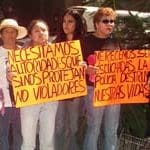Raped, Beaten, Never Forgotten
When the women left their homes that May morning in 2006, they never imagined the horrific experience that lay ahead of them.
During a police operation in response to protests by a local peasant organization in San Salvador Atenco, more than 45 women were arrested without explanation. Dozens of them were subjected to physical, psychological and sexual violence by the police officers who arrested them.
In the case of one of the women, police officers pulled her hair, beat her, and forced her into a state police vehicle with her shirt pulled over her head. She was made to lie on top of other detainees, and during the journey to the prison, police officers sexually assaulted her repeatedly.
Once at the “Santiaguito” prison near Toluca in Mexico State, the prison doctors who examined many of the women failed to document all their physical injuries or to gather evidence of the sexual abuse they had suffered.

More than five years later, these brave survivors are still waiting for justice.
None of the officials responsible for their abuse have been held accountable. Federal authorities had conducted an investigation that resulted in a list of 34 names of police officers who were suspected of being responsible for the abuses, but the federal authorities concluded that these individuals should be prosecuted at the state level.
Almost no progress has been made in over a year. Now is the time to push for real justice and remind the federal government of Mexico that it has the ultimate responsibility to protect the human rights of its citizens, and not to let this impunity continue.
Case Background
On May 3rd and 4th, 2006, local flower sellers, having reached an agreement with municipal authorities whereby they would be permitted to sell their flowers in the main market square of San Salvador Atenco, municipality of Texcoco, State of Mexico, arrived on the morning of the 3rd only to find masses of state and municipal police waiting for them. A protest ensued, and in the police response to the protest, two people were killed (including a 14-year-old boy), and many were injured.
The following day, protests continued, drawing others from outside, including some from Mexico City who had come to investigate the deaths from the previous day. These protests were put down even more harshly by federal, municipal and state police forces, with beatings, house raids, and indiscriminate detentions of residents in their households or other bystanders not involved in the confrontation.
Of the hundreds detained, at least 45 were women. On the way to prison, in the state police vehicle, many of the women were beaten, raped, and otherwise sexually assaulted by police officers who had arrested them. Upon arriving at the prison, more than two dozen of the women complained of being sexually assaulted, but the prison’s medical staff merely stitched up their most obvious head wounds, conducting no forensic exams.
Many of the women were themselves charged with crimes such as “blocking public roads,” and served prison time, with the last of the women being released in 2008. Eventually, eleven of the women submitted formal complaints regarding the sexual assaults to the National Human Rights Commission after the Federal Attorney General of the Republic refused to accept the initial recommendations of the National Commission of Human Rights.
An investigation was begun at the state level, but appeared to consist mostly of conducting psychological exams of the women.
Eventually, the investigation was taken up at the federal level by the Office of the Special Prosecutor for Crimes of Violence Against Women and Human Trafficking (Fiscalía Especial para Delitos de Violencia contra las Mujeres y Trata de Personas – FEVIMTRA). In April 2008, the eleven women also formally submitted their case to the Inter-American Commission on Human Rights.
In 2008 and 2009, the FEVIMTRA investigation continued to move forward, albeit very slowly. One officer, whose victim was actually able to see his face and identify him, was charged with the minor crime of “libidinous acts.” He was convicted, but sentenced only to time served plus a small fine. He appealed the decision and was acquitted on appeal.
To date, no other officers have been criminally prosecuted, and only a small number were subjected to minor disciplinary actions shortly after the event.
Also in 2009, Mexico’s Supreme Court issued a statement affirming that human rights abuses did take place in Atenco, and urging the identification of those responsible. Amnesty International criticized the Supreme Court’s dismissing the alleged responsibility of senior state and federal officials. With this Supreme Court decision Mexico falls short of its obligations under international human rights law.
In late 2009, FEVIMTRA concluded its investigation and issued a report. The key points in the report are that:
- there was physical and psychological evidence that the women sustained injuries,
- these injuries do in fact amount to sexual assault and torture, and
- the report names 34 individuals it deems to be the responsible parties for these crimes.
The report urges the prosecution of the 34 named police officers, but notes that they are all state police, and therefore concludes that jurisdiction for their prosecution corresponds to Mexico State. With the federal government claiming that jurisdiction is now at the state level, Amnesty is worried that impunity will persist, despite the evidence gathered by FEVIMTRA.
At this point, the state government has not officially accepted jurisdiction over the case, and Amnesty International will continue to pressure the federal government, which has the ultimate responsibility for enforcing human rights in Mexico.

